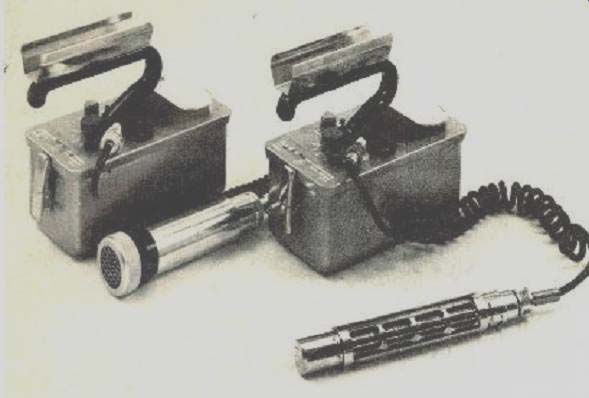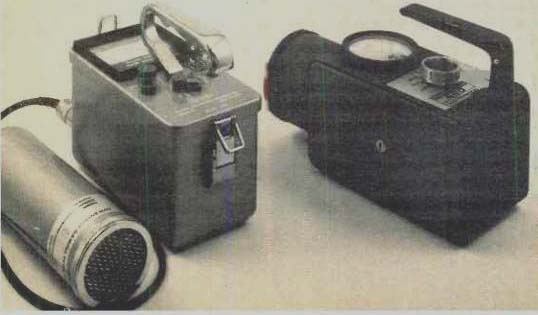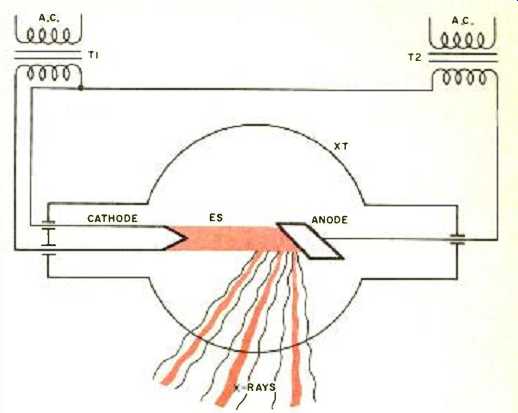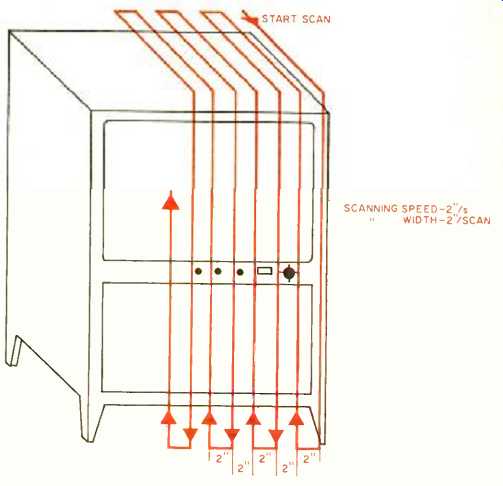By J. G. ELLO/Radiation Measurements & Instrumentation Industrial Hygiene & Safety Div., Argonne National Lab.
Types of survey instruments, comparative characteristics, and methods of checking color -TV receivers for excessive radiation.

--------- The end-window (left) and the thin-wall Geiger-Muller
(right) tube survey meters used by the author to detect the level of
x-radiation emitted from TV sets.
THE television receiver is a principal source of home entertainment and information but, like many other products, has its share of undesirable by-products. The automobile, steel mills, and power stations pollute the atmosphere with their noxious exhaust gases while television receivers emit an unwanted by-product called x-radiation Recognized since the black-and-white television receive came into being in 1946, x-radiation has become more of a problem since the advent of larger picture tubes requiring higher voltages.
In an effort to limit x-radiation levels, present television receivers are designed under the guidelines recommended by Underwriters' Laboratories and the National Council on Radiation Protection and Measurements. With the use of present-day radiation detection and measuring equipment, the author feels confident that TV-receiver manufacturers have reduced x-radiation to safe levels. Nevertheless, once the receiver leaves the factory, x-radiation levels may be altered if controls are improperly adjusted.
Color-TV receiver x-radiation, or x-rays as they are some times called, is only one source of radiation exposure with which the average consumer may come in contact. Other sources include: medical and dental x-rays, earthen materials used in building our homes, the sun, and in certain in stances industrial equipment on the job.
The Radiation Control Act of January, 1970 was passed to provide the TV viewers with as much protection from TV produced x-rays as possible. Standard levels set back in the 1950's, stipulating that x-ray emission from TV receivers must not exceed 0.5 milliroentgen per hour measured at about 2 inches from all outside surfaces of the TV receiver at the time of purchase, are now in effect. (A milliroentgen is sub -multiple of the roentgen and is equal to one one-thousandth of a roentgen. The roentgen is a quantity of x or gamma radiation that will produce one electrostatic unit of ions in one cubic centimeter of air.)
X-rays Reviewed
TV x-rays are produced mainly by the picture tube (CRT), rectifier, and high-voltage regulator tubes. Before we go any further, a brief review of what x-rays are and how they are produced is in order.
In 1895, a German physicist, W. C. Roentgen, discovered penetrating rays, which he called x-rays, while experimenting with the luminescence produced by cathode rays (electron emission from a cathode). Unlike nuclear alpha and beta radiation, x-rays are not affected by electrical or magnetic fields. When x-rays pass through air or a gas, the air or gas has the ability to conduct electricity, that is, x-rays produce electrically charged atoms (ions). They can also stimulate or disintegrate living tissues. Opaque materials, such as cardboard, wood, or books, that block visible (light) waves are transparent to x-rays. It is the ability of x-rays to affect the sensitive emulsion of photographic film that makes it ideal for use in the medical field. We could say x-rays are of the same nature as light, but with a shorter wavelength.
A basic x-ray generating circuit, in which the x-ray tube functions as its own rectifier, is shown in Fig. 2. The secondary winding of transformer T1 furnishes the filament current for x-ray tube XT and transformer T2 furnishes the necessary high -voltage potential between the electrodes (cathode and anode). Once the x-ray tube is energized, its cathode will release electrons, causing the electron stream ES (cathode ray) to accelerate at very high speeds to the anode. It is the impact of the swiftly moving electron stream on the anode that produces the x-rays (secondary emission). Similarly, x-rays of various energies (intensities) can be produced by electron tubes which are capable of accelerating electrons to energies of several thousand electron volts (eV). The higher the voltage across the electrodes of the x-ray producing tube, the higher the x-ray intensities and the greater the penetration. Potentials at, say, 100,000 volts across the tube electrodes will produce x-rays with penetrating power that would show the bones of the hand while lower potentials, about 10,000 to 40,000 volts, produce lower energy rays, referred to as soft x-rays. Soft x-rays are easily absorbed by matter and have energies below 50,000 electron volts (50 keV). Consequently, any electron tube with the potential of accelerating electrons to energies of several thousand electron volts can produce x-rays.
TV X–rays
Color-television receivers have been known to emit x-ray levels in excess of 0.5 milliroentgen per hour (0.5 mR /hr). It was also found that the amount of x-rays radiated from color-TV receivers is related to the input a.c. line voltage. For example, a five -volt increase in line voltage is capable of increasing the x-ray level by a factor of two. As mentioned earlier, the CRT is one of the main sources of x-rays from color-TV receivers. Here the primary x-rays emanate from the CRT's faceplate. In shunt-regulator tubes, x-rays are generated at the anode and in high-voltage rectifiers at the cathode (due to the reverse cycle of the sweep cycle). This occurs when the d.c. high voltage is applied across the rectifier in a reversed direction; the anode is at negative high voltage. The x-rays from the CRT's faceplate are absorbed somewhat by the picture tube's glass panel and on more recent color -TV CRT's by the steel shadow mask. X-rays from the rectifier and shunt -regulator tubes are absorbed by the glass envelope and the steel tube shields.
The x-rays that bypass the absorbers are of various energies, ranging from approximately 10,000 to 35,000 eV. Appropriate radiological survey instruments are required to detect and measure these x-rays. Some of these may cost thousands of dollars, such as the pulse-height spectrometer, or hundreds of dollars, such as battery -powered survey meters. Fortunately, the technique for identifying the TV x-ray spectrum is known and simpler radiological survey meters may be used to monitor color-TV receivers.
Since the theory behind the operation of survey meters can be found in a number of texts, we will confine our discussion to how a survey meter can be used to spot x-rays from color-TV receivers and which type is best for the job.

Fig. 1. (Left) Eberline Instrument Corporation's scintillation type
and (right) Victoree Company's ionization chamber are two other survey
meters used to detect x-rays from TV sets.
TV X-ray Energies
To determine what x-ray energies are emitted from color-TV receivers, studies were conducted by taking readings from specially adjusted color -TV receivers, using a pulse-height scintillation spectrometer. It was found that if a 25-inch rectangular color picture tube were operated above the recommended voltage, the overall x-ray energy spectrum emanating from the TV receiver would be between 10 and 31 keV. The tests showed that from the face of the picture tube, x-ray energies would range from approximately 19 to 25 keV with a peak at about 24 keV. The x-ray energy range from the shunt regulator was about 10 to 25 keV with peaks at 12.7 and 24 keV and the high-voltage rectifier produced x-ray energies from about 10 to 31 keV with a peak at about 26 keV. As the high voltage increased or decreased, so did the x-rays emitted from the TV receiver. For example, when the high voltage was raised above the recommended selling the measurable amount of x-rays increased.
Measurable x-rays emanating from a color-TV set can range up to about 31 keV. Of these, the lower energy x-rays are easily absorbed by matter such as cardboard, while other energies pass through. This is similar to a light beam passing through a couple of sheets of tissue paper, which absorbs a certain portion of the light. Therefore, when measuring or detecting x-rays emanating from TV receivers, it should be kept in mind that the material from which the detector is constructed will also absorb some of the x-rays.
Since x-rays emanating from color-TV receivers are of various energy levels, an ideal detector would be one that has a flat response to the whole energy spectrum. Unfortunately, no such detector is readily available, but there are a number of detectors which are susceptive to soft x-rays and with proper calibration against a known x-ray source (which is in agreement with the National Bureau of Standards), can be used for detecting TV's soft x-rays.
X-ray Detectors
The lead photo shows an end-window and a thin-wall Geiger-Muller (GM) tube survey meter. The end-window GM tube (at the left) consists of a very thin mica window approximately 1.4 milligrams/cm^2 thick and with an active area approximately 1 1/8" in diameter. The other GM tube consists of a very thin aluminum cylinder approximately 30 milligrams / cm^2 thick and with an active area 2 3/4" long.
The energy response of these two types of GM tubes is poor for determining a dose rate. The data sheet on the thin-wall GM tube (1B85) shows it to be sensitive down to about 10 keV while the end -window GM tube fares a little better.
One reason for a poor response is that the detection of soft x-rays (uncharged particles) requires the production of secondary electrons. Secondary electrons produced by the soft x-ray interactions are easily absorbed directly by the GM tube counting gas. The efficiency of such GM tubes depends on how many x-rays are absorbed by the GM tube and also how many secondary electrons reach the interior of the detector. Accurate calibration may be difficult because of these complications, including the energy and path of the secondary electrons. The GM-tube survey meter may be used as a "go /no-go" instrument for localizing beams that are emanating from color-TV receivers, such as those from the shunt and high-voltage rectifier tubes. They also will give an indication if excessive amounts are emanating from the picture-tube face.
Survey meters associated with the two types of GM tubes shown in the lead photo have three linear ranges, from 0 to 50 mR/hr. The readout consists of 0-50 microammeter and a phone jack for aural monitoring. The meters are powered by two carbon "D" cells with a battery life of about 300 hours.
Two other types of instruments that can be used for detecting TV x-rays are shown in Fig. 1 with the scintillation type on the left and the ionization chamber on the right.
The scintillation detector has come into its own in the last decade although scintillation is not new. It is one of the oldest methods of detecting nuclear radiation through the process of scintillation in a phosphorous material. With improvements in photomultiplier tubes, the scintillator gained wide acceptance. The scintillation detector contains a photomultiplier tube and a NaI (Tl) crystal (sodium-iodide activated with thallium). Such a scintillator detector would respond to all low-energy x-rays were it not for its protective screen and opaque Mylar window, which absorbs the very -low-energy x-rays. Other limitations on low-energy sensitivity is the natural background from gamma and cosmic rays and from the thermionic current noise within the photomultiplier tube and its associated circuits. The energy response of the scintillator is well within the color-TV x-ray emission range. With its protective screen removed, x-rays down to 3 keV can be detected above the natural background. The small active area of the scintillator is ideal for detecting narrow x-rays beams from TV sets.
The survey meter used with the scintillator detector is a battery-powered pulse-count -rate meter with single-channel, pulse-height analyzer capability. It has three separate channels with high -voltage adjustments. The survey meter readout consists of a dual scale and pointers. The meter indicates counts per minute and, with proper calibration, the counts can be converted into mR/hr readings. Battery life is approximately 350 hours when mercury cells are used.
The other type detector, is an ionization chamber. The ionization chamber is widely used in dose -rate survey meters and is calibrated to read directly in mR/hr. Most battery-operated ionization survey meters consist of vacuum tube electrometers. For increased sensitivity, a vibrating-reed electrometer is used as in the ionization meter shown.
Ionization chambers are versatile in that all types of nuclear radiation which produces either primary or secondary ionization within the chamber may be detected. They may also be constructed in various shapes. Many chambers which have a very thin Mylar window are sensitive down to about 4 keV depending, of course, on the detector design and its counting circuit. Energies below 4 keV are easily attenuated by the chamber walls and therefore cannot penetrate it. Data that is available on the ionization survey meter shows a relatively flat response down to about 6 keV, which is well within the range of x-rays emanating from malfunctioning color -TV receivers. The ionization survey meter is battery powered utilizing 4 carbon "D" cells with a life expectancy of approximately 100 hours. It has a range from 0 to 300 mR /hr and is calibrated to read directly in mR /hr.
Radiographic X-ray Film
There are other ways of detecting x-rays. One is by means of radiographic medical x-ray film. Radiographic film is widely used for monitoring personnel working with or near ionizing radiation. This same principle has been applied to monitoring color-TV sets for x-ray emission. The film has proven useful in detecting narrow x-ray beams produced by shunt -regulator and high-voltage rectifier tubes.
The film may be packaged in various sizes and the package may contain one or more types of film.
The film consists of an emulsion containing silver-iodide or silver-bromide crystals imbedded in a gelatin mix which is spread on a base support. The film is then packaged in an opaque material. Absorption of low-energy x-rays is a problem, therefore film sensitivity depends both on the packaging material and the size crystal used. The film can be made sensitive down to the 6 -keV x-ray energy range. Unlike the other types of detectors mentioned previously, the film needs no electronics for its ionization process. The x-ray's interaction with the emulsion compound causes the release and trapping of electrons. The trapped electrons in the crystals cause a darkening of the film during the developing process. The film response, or darkening, is proportional to the intensity of the x-rays; that is, the greater the intensity, the darker the film will get. After developing, the film is viewed by a densitometer. Readings from the densitometer are then converted into mR /hr readings. To monitor a TV receiver, a film packet is attached to each side of the TV receiver. After a proper time exposure, the film is developed for dark clouding or images that indicate x-ray exposure.
To sum up, at present there is no all-around survey meter for TV x-ray monitoring. Calibration of the survey meter must be known. Conversion to an mR /hr reading must be certain and the accuracy of the low -level reading in the 0.5 mR /hr range must be dependable. Sensitive detectors such as the GM detectors in the lead photo and the scintillation detector which are energy-dependent, are quite capable of detecting low-energy x-rays providing the energy in question is known. They are useful in detecting small x-ray beams such as those produced by the shunt-regulator and high-voltage rectifier tubes. The ionization survey meter is not suitable for beam measurements. This is because of the large area of the ionization chamber. However, it is suitable for measuring x-rays emanating from the face of the TV picture tube. In the author's opinion, an ionization-type survey meter with interchangeable ionization chambers accurately calibrated in mR /hr would be an ideal TV -monitoring survey meter. The scintillation detector would come second only because it is very sensitive and therefore affected by natural background radiation. Monitoring with radiographic x-ray film, in the author's opinion, is too slow for home use.

Fig. 2. Basic x-ray tube (XT) circuit showing how x-rays are produced
when accelerating electron stream (ES) strikes anode.

Fig. 3. Diagram showing method used by the author for scanning TV receiver
for x-rays. Meter should be held no more than 2" from all cabinet
surfaces while maintaining scanning width of 2"/scan and a scanning
speed of approximately 2"/s.
TV X-ray Surveying
Color-television receivers are designed to limit x-radiation below the maximum value stated in the Radiation Control Act of January, 1970. If for some reason a TV receiver is suspected of emitting x-rays above the maximum level, it should be surveyed. Although as this article is being written there is no standardized procedure for TV surveys, the following technique was used by the author.
Preferably, the survey should be conducted during the daylight hours when the a.c. line voltage is highest. The choice of survey meters will depend on the surveyor's ability and knowledge of radiation -detection technology. The author has used both GM and scintillation-survey meters to survey for small x-ray beams and the ionization-type survey meter for broad area beams such as those which might be emitted from the face of the color picture tube. A single survey meter may be used, provided you are thoroughly familiar with its characteristics, calibration, accuracy, and energy dependence.
To begin with, the TV set should be "off " and a background count taken. This background reading will then be subtracted from x-ray readings (if any). The high-voltage control should be adjusted by an authorized factory representative in accordance with factory specifications. In most cases, since the TV receiver was factory adjusted, there should not be any above-acceptable x-rays emanating from it. Using just the front -panel controls of the TV set, survey the receiver under four operating conditions: 1. set the brightness control for the darkest viewing picture, 2. set the brightness control for maximum brightness, 3. set the TV receiver off -channel with maximum brightness, and 4. survey the TV with the brightness control set for normal viewing.
When performing a survey, pass the survey meter and /or detector very slowly about 2 inches from all cabinet surfaces, including the bottom and rear of the TV set (see Fig. 3). Above all, remember that the x-ray reading on the meter will fluctuate and an average reading should be taken. If readings above acceptable levels are detected, you can in most cases reduce x-rays to a safe level by performing one or more of the following: 1. properly adjusting the high voltage, 2. replacing the high -voltage and /or shunt-regulator tubes, and 3. installing tube shields. Once the suspected fault has been corrected, the TV set should again be surveyed to insure that the x-radiation has been minimized.
A word of caution for the electronics service technician. Always be consciously aware of the possibility of radiation emission from other products as well as from TV receivers.
Full knowledge of the products you service is a "must" in order to protect yourself, and those around you, from these insidious hazards. In many service shops, service technicians and their fellow workers risk unnecessary exposure.
To cite one example, a color-TV receiver was out of its cabinet, lying on the side of the chassis with high -voltage tube shielding missing, and the set turned on. This is not only an electrical hazard, but also a radiation hazard. A TV receiver, which must be "on" after repairs, should be isolated from service personnel. The service technician working on a TV receiver should disable all hazardous circuits or use radiation shielding. The high voltage should be checked and /or adjusted as per the manufacturer's specifications with a calibrated high-voltage meter and probe combination before the color-TV receiver is returned to its owner.
For those who may want to build their own GM survey meters, the Public Health Service has issued a booklet entitled, "Simple X-ray Detection Instrument for Television Service Technicians." The PM number is BRH /DEP 70 -14.
The booklet costs $3.00 and is available from the Clearinghouse for Federal, Scientific, and Technical Information, Springfield, Virginia 22151.
The Victoreen Company and the Eberline Instrument Corp. have complete lines of battery-operated color-TV survey instruments for anyone wishing to purchase one. Information is available by writing to: Victoreen Instrument Div., 10101 Woodland Ave., Cleveland, Ohio 44104 and to Eberline Instrument Corp., Santa Fe, New Mexico.
REFERENCES
"Conference on Detection and Measurement of X-ray Radiation from Color Television Receivers." U.S. Department of Health, Education, and Welfare, Public Health Service.
"Color Television and the X-ray Problem." Federal Trade Commission
(adapted from: Electronics World magazine; Jul. 1975)
================